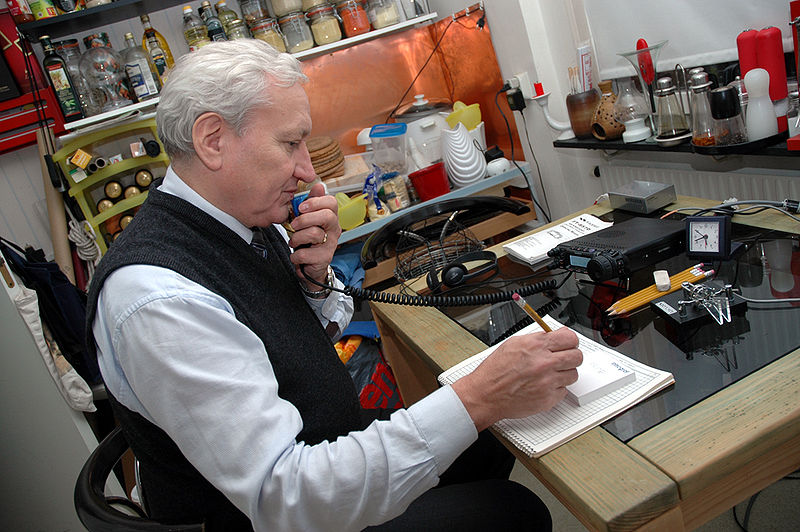
Many hams are entering retirement and considering a move into a retirement community. What are the opportunities and problems of trying to continue in Amateur Radio in such a community? We are finding that a number of senior living communities look with favor upon the needs of the ham operator, either as a single operator from an apartment or as a member of a club of two or more hams.
This web article is aimed at two important audiences:
- Administrators of retirement communities. What is Amateur Radio? Who are the "hams"? Why would we want to support ham radio activities in our facility?
- Radio amateurs considering how to keep active with their chosen hobby after moving to a retirement community. What's a reasonable request for an antenna? How do I approach the management? How have other hams worked out these problems?
We are trying here to assemble the information you might need when contemplating a move or when you would like to continue or even start up ham radio activity in a retirement community setting. We also present web links that highlight the ham radio situation at a number of communities around the U.S. (We solicit your contributions, too. Send them to
About Amateur Radio in Retirement Communities
The term "retirement community" covers a wide range of living arrangements that support the particular needs of people over age 60 (typically). An important question for active radio amateurs is whether they can continue with their hobby in their retirement setting. Since home-owning hams often have spent years building a station, they are generally faced with the prospect of downsizing in terms of space and antenna options. The problems faced in a retirement community are often similar to those that many non-senior apartment dwellers have -- how to get a landlord's approval and how to operate close to neighbors.
This article mainly is oriented toward larger communities that may have the resources and inclination to listen to their residents' odd wishes, like ham radio!
What is ham radio?
Amateur Radio has been around as long as there has been radio, well over 100 years. As mentioned above, there are large numbers of licensed operators who enjoy talking with the world and working with the latest communications technology. The following is a quick introduction for anyone who is new to ham radio.
The U.S. Federal Communications ComHam Radio and Senior Community Internet storiesmission (FCC) has this to say about the Amateur Radio Service:

"The amateur and amateur-satellite services are for qualified persons of any age who are interested in radio technique solely with a personal aim and without pecuniary interest. These services present an opportunity for self-training, intercommunication, and technical investigations. Twenty-seven small frequency bands throughout the spectrum are allocated to this service internationally...
"Millions of amateur operators in all areas of the world communicate with each other directly or through ad hoc relay systems and amateur-satellites. They exchange messages by voice, teleprinting, telegraphy, facsimile, and television...
"All frequencies are shared. No frequency is assigned for the exclusive use of any amateur station. Station control operators cooperate in selecting transmitting channels to make the most effective use of the frequencies. They design, construct, modify, and repair their stations..." (FCC website.)
In order to participate in Amateur Radio you must pass an FCC license examination that covers radio, electronics and regulatory information. Hams have rather wide latitude to select their operating frequency and type of transmission that allows them to "work" other amateurs across town or around the world, depending on circumstances.
For more details, check my article What is Amateur Radio?
(Note that Amateur Radio is quite distinct from Citizens Band (CB) radio. CB operators are only allowed to use a few frequency channels and must legally use low operating power. They need not prove any technical knowledge, and they are not licensed. For the most part, CB radio is for relatively short range communications.)
Why would a retirement community want to have Amateur Radio?
 Consider the following points:
Consider the following points:
- Amateur Radio is known as a good method of communications in emergency situations. Our motto: "When all else fails." Amateur Radio does not depend on infrastructure like cell phone towers, repeaters, phone lines, or Internet connections. A modest AC generator keeps us on the air.
- An Amateur Radio capability provides a marketing point -- attractive to a certain number of technically-adept people from a wide range of life experiences that can enrich any community.
- Radio amateurs are often interested in engaging with area ham clubs, public agencies, and schools. They can help sustain ties to the wider community.
- Learning about radio technology, obtaining a license, and "talking with the world" is a hobby that can show new horizons to retired persons.
We can think of more!
What do hams need for successful operation in a retirement community?
 Typical retirement communities have apartments or living areas that are similar to other apartment or condominium buildings. They are relatively high density, and they are managed by the community organization (i.e. the landlord). This physical situation can present a challenge for some kinds of amateur radio antennas.
Typical retirement communities have apartments or living areas that are similar to other apartment or condominium buildings. They are relatively high density, and they are managed by the community organization (i.e. the landlord). This physical situation can present a challenge for some kinds of amateur radio antennas.
[Amateur Radio antennas come in many shapes and sizes, depending on the frequency bands in use. For short range "VHF" or "UHF" communications, a whip antenna of up to a few feet in length may be enough. But for "HF" (high frequency, long distance or "shortwave") a wire of 120 ft or longer may be the best choice. For best long distance work, a "beam" antenna (resembling a very large old-style TV antenna) mounted with a rotator on a high (40-80 ft) tower is often used.]
Fortunately, hams have ways to use "compromise" (smaller) antennas that can be more easily adapted to apartment life.
Modern radio receivers and transmitters can be quite small and may not need more than a desktop in a typical apartment. (Some are simply hand-held "walky talky" units.) You may have some wiring issues, particularly to connect an outdoor antenna to an indoor radio.
Amateur Radio clubs
If there are two or more licensed amateurs in a retirement community, you might want to establish a "club" station. I.e. one that is shared among its members. In this case, you need to find a suitable room for the equipment and antenna connections. The room needs physical security (to protect valuable equipment and prevent unauthorized operation). An air conditioned (non-condensing) environment is desirable.
Compatibility with other devices
In earlier times, Amateur Radio operations sometimes caused television interference, which could be a problem in apartment living. Nowadays this is much less common, with digital cable TV being the rule. There is still some potential for transmissions to be received by audio equipment like computer speakers or stereo players. Amateurs will need to be aware of these possibilities and be receptive to working out any problems with neighbors. Reducing operating power or operating hours may be a solution, and there are also some simple technical solutions, such as installing filters on the affected devices.
Ham Radio and Senior Community Internet stories
Please check our big list: Ham Radio and Senior Friendly Community Links. You will find online results about ham activity at some 20 locations in 12 states, along with published articles. If you would like your club or community highlighted here, please send your information to the address below.
Compiled by Martin Ewing, AA6E (
Published on https://aa6e.net/senior-living-for-hams May, 2023.